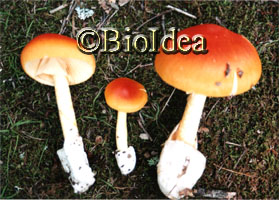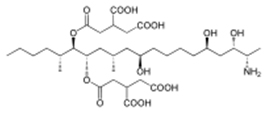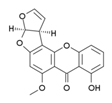Mycotoxins from Molds
Activly growing molds also disseminate smaller volatile molecules into our living environment as microbial volatile organic compounds (MVOCs). MVOCs are not mycotoxins, but will make us sick and allergic with chronic symptoms if exposed pretty long.
 Toxic mushrooms or toadstools produce mycotoxins as well. Those mycotoxins are different from those produced by molds, since mushroom toxins poison people when they are consumed by people as neuronal, liver, blood or stomach toxins. Some mycotoxins are very potent, such as that from Amanita species (the death cap genus). Mushrooms in this genus have a significant typical wrapping foot or enlarged foot blob, a ring at the middle of the stalk, and some with colorful caps with or without warts.
Toxic mushrooms or toadstools produce mycotoxins as well. Those mycotoxins are different from those produced by molds, since mushroom toxins poison people when they are consumed by people as neuronal, liver, blood or stomach toxins. Some mycotoxins are very potent, such as that from Amanita species (the death cap genus). Mushrooms in this genus have a significant typical wrapping foot or enlarged foot blob, a ring at the middle of the stalk, and some with colorful caps with or without warts.Common mycotoxins from molds include: Aflatoxin, Amatoxin, Citrinin, Cytochalasin, Fumonisin, Gliotoxin, Ibotenic acid, Muscimol, Ochratoxin, Patulin, Sterigmatocystin, Trichothecene, Vomitoxin, Zeranol, and Zearalenone. Some are listed below.
Aflatoxins  Aflatoxins are naturally occurring mycotoxins that are produced by many species, esp. in Aspergillus flavus and Aspergillus parasiticus. They are largely associated with products in the tropics and subtropics. Aflatoxins are toxic and among the most carcinogenic substances known. Cereals crops are frequently contaminated. Aflatoxin B1, the most toxic, is a potent carcinogen and has been associated with liver cancer.
Aflatoxins are naturally occurring mycotoxins that are produced by many species, esp. in Aspergillus flavus and Aspergillus parasiticus. They are largely associated with products in the tropics and subtropics. Aflatoxins are toxic and among the most carcinogenic substances known. Cereals crops are frequently contaminated. Aflatoxin B1, the most toxic, is a potent carcinogen and has been associated with liver cancer.
Citrinin  Citrinin is a mycotoxin originally isolated from Penicillium citrinum. Now it has been found in several species of Aspergillus and Penicillium. Citrinin is a nephrotoxin in animals.
Citrinin is a mycotoxin originally isolated from Penicillium citrinum. Now it has been found in several species of Aspergillus and Penicillium. Citrinin is a nephrotoxin in animals.
 Fumonisin B1 is the most prevalent member of a family of toxins produced by several species of Fusarium molds which occur mainly in maize. Fumonisin B2 is a mycotoxin produced by the fungus Fusarium verticillioides and is more toxic than B1.
Fumonisin B1 is the most prevalent member of a family of toxins produced by several species of Fusarium molds which occur mainly in maize. Fumonisin B2 is a mycotoxin produced by the fungus Fusarium verticillioides and is more toxic than B1.Gliotoxin
 Gliotoxin, originally isolated from Gliocladium fimbriatu, is an antibiotic produced by molds Aspergillus, Trichoderma, and Penicillium. Gliotoxin possesses immunosuppressive properties as it may suppress and cause apoptosis in certain types of cells of the immune system.
Gliotoxin, originally isolated from Gliocladium fimbriatu, is an antibiotic produced by molds Aspergillus, Trichoderma, and Penicillium. Gliotoxin possesses immunosuppressive properties as it may suppress and cause apoptosis in certain types of cells of the immune system. Ochratoxin A, B, and C are mycotoxins produced by some Aspergillus species and Penicillium species, like Aspergillus ochraceus or Penicillium viridicatum. Ochratoxin A, produced by Penicillium verrucosum, and Aspergillus species in temperate climates, is considered a carcinogen. Aspergillus carbonarius is the other main species of this toxin causing kidney damage.
Ochratoxin A, B, and C are mycotoxins produced by some Aspergillus species and Penicillium species, like Aspergillus ochraceus or Penicillium viridicatum. Ochratoxin A, produced by Penicillium verrucosum, and Aspergillus species in temperate climates, is considered a carcinogen. Aspergillus carbonarius is the other main species of this toxin causing kidney damage.Patulin  Patulin is associated with a range of fungal species and is found in moldy fruitss vegetables, cereals and other foods. It may be carcinogenic and is reported to damage the immune system and nervous systems in animals.
Patulin is associated with a range of fungal species and is found in moldy fruitss vegetables, cereals and other foods. It may be carcinogenic and is reported to damage the immune system and nervous systems in animals.
Sterigmatocystin  Sterigmatocystin (similar to Aflatoxin) is a dermatoxin, isolated from Aspergillus. It occurs on crusts of cheese with mold. Toxic effects in lab animals have included kidney and liver damage, skin and hepatic tumors.
Sterigmatocystin (similar to Aflatoxin) is a dermatoxin, isolated from Aspergillus. It occurs on crusts of cheese with mold. Toxic effects in lab animals have included kidney and liver damage, skin and hepatic tumors.
 Trichothecenes are a very large family of mycotoxins produced by molds Fusarium, Myrothecium, Trichoderma, Trichothecium, Cephalosporium, Verticimonosporium, and Stachybotrys (Stachybotrys chartarum, the Black Mold, Sick-Home-Syndrome agent). This group of mycotoxins has a strong immunosuppressive effect.
Trichothecenes are a very large family of mycotoxins produced by molds Fusarium, Myrothecium, Trichoderma, Trichothecium, Cephalosporium, Verticimonosporium, and Stachybotrys (Stachybotrys chartarum, the Black Mold, Sick-Home-Syndrome agent). This group of mycotoxins has a strong immunosuppressive effect. Griseofulvin (= Grisovin), originally from Penicillium griseofulvum, is an antifungal drug to treat ringworm fungal infections of the skin and nails (ironically kill other molds). It is potential for cancer treatment due to its interruption for cancer cells to divide. But this toxin has too many negative health effects.
Griseofulvin (= Grisovin), originally from Penicillium griseofulvum, is an antifungal drug to treat ringworm fungal infections of the skin and nails (ironically kill other molds). It is potential for cancer treatment due to its interruption for cancer cells to divide. But this toxin has too many negative health effects.
Compiled by BioIdea.net Ref: www.wikipedia.org for partial contents.
